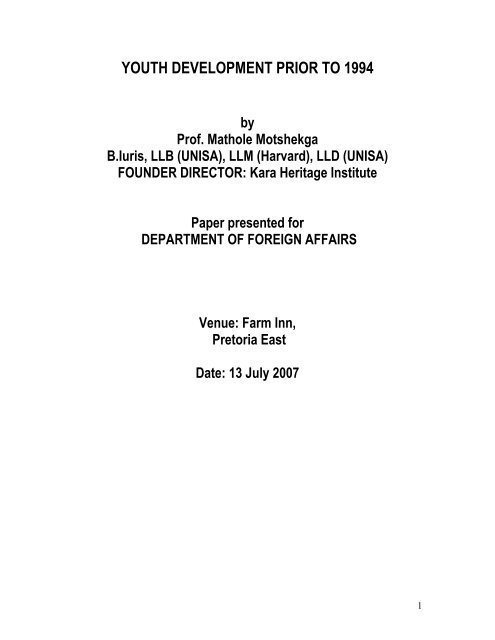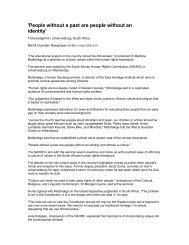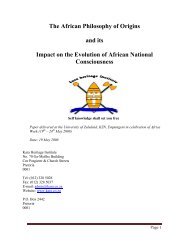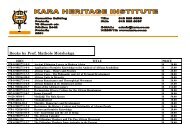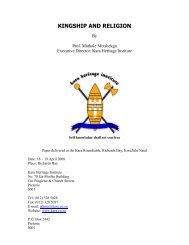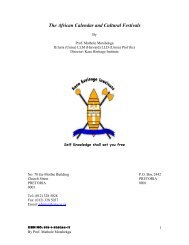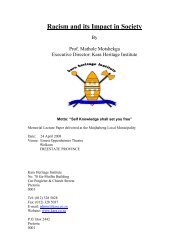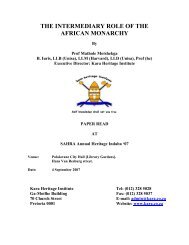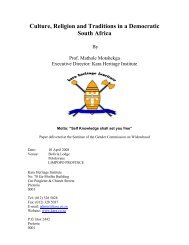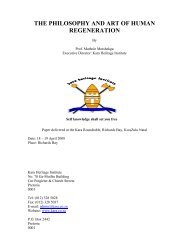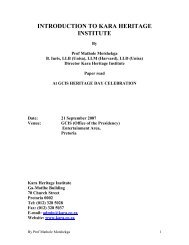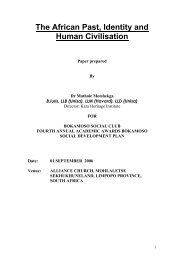Youth Development prior to 1994 dept of foreign affairs ... - Kara.co.za
Youth Development prior to 1994 dept of foreign affairs ... - Kara.co.za
Youth Development prior to 1994 dept of foreign affairs ... - Kara.co.za
Create successful ePaper yourself
Turn your PDF publications into a flip-book with our unique Google optimized e-Paper software.
YOUTH DEVELOPMENT PRIOR TO <strong>1994</strong><br />
by<br />
Pr<strong>of</strong>. Mathole Motshekga<br />
B.Iuris, LLB (UNISA), LLM (Harvard), LLD (UNISA)<br />
FOUNDER DIRECTOR: <strong>Kara</strong> Heritage Institute<br />
Paper presented for<br />
DEPARTMENT OF FOREIGN AFFAIRS<br />
Venue: Farm Inn,<br />
Pre<strong>to</strong>ria East<br />
Date: 13 July 2007<br />
1
Contending Ideologies in South Africa<br />
Some African slaves in the Americas resisted their masters and fled <strong>to</strong> mountains were they<br />
<strong>co</strong>ntinued <strong>to</strong> live independently and maintained their identity, culture and traditions. The majority <strong>of</strong><br />
the slaves who remained under white <strong>co</strong>ntrol were tamed through Christianity. During the 1700’s<br />
freed slaves who remained within the white church establishment were discriminated against and<br />
forced <strong>to</strong> secede from white churches <strong>to</strong> form independent Ethiopian churches.<br />
The formation <strong>of</strong> the Ethiopian church was motivated by the prophesy in Psalm 68:31 which says<br />
that Princesses shall <strong>co</strong>me out <strong>of</strong> Egypt and Ethiopia shall stretch her hands <strong>to</strong>wards god. The<br />
biggest Ethiopian <strong>co</strong>ngregation which was formed by African – American secessionist led by<br />
Bishop Turner was the African Epis<strong>co</strong>pal Methodist (AME) church.<br />
In South Africa churches and schools in African <strong>co</strong>mmunities were <strong>co</strong>lonized in the 1880’s – 90’s<br />
by stricter mission <strong>co</strong>ntrol and a rush <strong>of</strong> immigrant white clergymen and teachers. This created a<br />
grievance for many experienced African clergymen, who had previously been in charge <strong>of</strong> church<br />
and school management and finance under only minimal mission <strong>co</strong>ntrol.<br />
The missionary management <strong>of</strong> schools and churches in the African <strong>co</strong>mmunities discriminated<br />
against the African clergymen and suppressed African identity, culture and traditions. Some African<br />
clergymen led their <strong>co</strong>ngregations out <strong>of</strong> the European missions <strong>to</strong> be<strong>co</strong>me independent churches,<br />
<strong>of</strong>ten supported by local Chiefs as the national church <strong>of</strong> the local <strong>co</strong>mmunity. African clergymen<br />
particularly in the Wesleyan (Methodist) and <strong>co</strong>ngregational churches claimed it was their right in<br />
the spirit <strong>of</strong> Protestantism <strong>to</strong> form churches free from alien <strong>co</strong>ntrol.<br />
The first independent African church was the Thembu National church, founded by Rev. Nehemiah<br />
Tile in 1884.Tile quarreled with the Wesleyan mission when it tried <strong>to</strong> s<strong>to</strong>p him from involvement in<br />
Thembu politics, suppressed Xhosa culture and traditions in the church and <strong>co</strong>ndemned his<br />
support <strong>of</strong> initiation ceremonies <strong>of</strong> the Thembu Nation when Thembuland was annexed by the<br />
Cape <strong>co</strong>lony Tile was arrested and imprisoned. But his influence spread <strong>to</strong> other black Wesleyan<br />
ministers elsewhere.<br />
In 1892 a section <strong>of</strong> Africans seceded from the Berlin mission <strong>to</strong> form the Independent Lutheran<br />
Bapedi church led by its former white missionary. On the rand African preachers found ready<br />
<strong>co</strong>ngregations among migrant workers in the urban areas <strong>of</strong> Kimberly, Johannesburg and Pre<strong>to</strong>ria.<br />
One such preacher was James Brander (or Kanyane Napo), who quarreled with the Anglican<br />
mission over land he had obtained for a church in the Northern Transvaal. He settled at<br />
Marabastad outside Pre<strong>to</strong>ria in 1889 <strong>to</strong> found his own independent African church.<br />
The Birth <strong>of</strong> the Ethiopian Church in South Africa<br />
In Southern Transvaal (now Gauteng Province) African Wesleyan ministers, African like Tile in<br />
Thembuland, quarreled with white missionaries over racial discrimination and suppression <strong>of</strong><br />
African identity, culture and traditions. In 1892 the African Wesleyan ministers marched out <strong>of</strong> a<br />
mission <strong>co</strong>nference in Pre<strong>to</strong>ria, under the leadership <strong>of</strong> Mangena Mokone a powerful preacher,<br />
who declared:<br />
“We are called Revs. But we are worse than the boy working for the missionary.”<br />
2
Mokone <strong>co</strong>mbined with Kanyane Napo in one church for all Africans regardless <strong>of</strong> ethnicity.<br />
They formed the Ethiopian church <strong>of</strong> South Africa in 1892 <strong>to</strong> fulfill the prophesy that ‘Ethiopia shall<br />
soon stretch out her hands un<strong>to</strong> god Psalm 68 verse 31’. The number <strong>of</strong> Ethiopian churches in<br />
Marabastad soon rose <strong>to</strong> twelve <strong>co</strong>ngregations Johannesburg and Orange Free State independent<br />
Wesleyans <strong>co</strong>ngregations joined in 1893 – 94, under Revs. Jantjie Tantsi, Ja<strong>co</strong>bus Xaba and<br />
others. Mokone persuaded the Thembu church, now led by Jonas Goduka (since the death <strong>of</strong> Tile<br />
in 1892) and calling itself the African Native Church <strong>to</strong> join the Ethiopian church in 1895.<br />
At the same time Mokone began enquiries about the Ethiopian church affiliating <strong>to</strong> the African<br />
Methodist Epis<strong>co</strong>pal (AME) church, the largest and most powerful black church in the United<br />
States <strong>of</strong> America. Mokone learnt about the AME church from charlotte Makgomo Manye, a South<br />
Africa student at the AME church’s Wilberforce Institute. James Dwane, an ambitious new recruit<br />
visited AME church in Philadelphia where he amalgamated the Ethiopian church <strong>of</strong> South Africa<br />
and the AME church and made the former the fourteenth district <strong>of</strong> the latter. James Dwane was<br />
appointed supervisor <strong>of</strong> the Ethiopian church while Mokone was reduced <strong>to</strong> presiding elder (1896)<br />
<strong>of</strong> his own church and in his absence. This led <strong>to</strong> a split <strong>of</strong> the Ethiopian church.<br />
However, the church under Dwane flourished and grew as never before in<strong>co</strong>rporating more and<br />
more African <strong>co</strong>ngregations including <strong>co</strong>loreds in Cape Town who broke away from white mission<br />
<strong>co</strong>ntrol. Ethiopianism gave many Africans new hope in the face <strong>of</strong> white <strong>co</strong>nquest, destruction <strong>of</strong><br />
African kingdoms and suppression <strong>of</strong> African identity, culture and traditions.<br />
Although not all breakaway churches from European missions joined the Ethiopian church in the<br />
1890’s they shared the Ethiopianist sentiments. The Zulu <strong>co</strong>ngregational church, founded at<br />
Pietermaritzburg in 1897, was a protest against the American Board (Congregationalist) missionary<br />
society handing over Afrivan <strong>co</strong>ngregations <strong>to</strong> the white settler <strong>co</strong>ngregational union <strong>of</strong> South<br />
Africa. In the Eastern Cape Pambani Mzimba, the senior African minister <strong>of</strong> the Free (Presbyterian)<br />
church <strong>of</strong> S<strong>co</strong>tland, seceded and founded The African Presbyterian church. By 1903 his church<br />
had 6500 members and 22,000 followers, including former Methodists and Anglicans as well as<br />
Presbyterians.<br />
Admission <strong>of</strong> the Ethiopian church in<strong>to</strong> the AME church<br />
Following the agreement between James Zwane and the AME church Authorities in Philadelphia<br />
Bishop Henry McNeal Turner <strong>of</strong> the African Methodist Epis<strong>co</strong>pal church arrived in South Africa <strong>to</strong><br />
admit the Ethiopian church formally in<strong>to</strong> the AME church as its fourteenth Epis<strong>co</strong>pal district in<br />
1898. Turner was already famous as the main spokesperson <strong>of</strong> the “Back <strong>to</strong> Africa” campaign.<br />
In America the AME church and the Prince Hall Masonic Lodges were the main motive forces for<br />
change. The Prince Hall Lodges produced Pan African leaders such as Brooker T. Washing<strong>to</strong>n,<br />
W.E.B. Du Bois and Marcus Garvey. The AME church and the Prince Hall Lodges shared<br />
resourced and facilities.<br />
In South Africa Turner, like the Pan Africanist members <strong>of</strong> the Prince Hall Lodges, preached<br />
African pride, self-help and self-reliance everywhere he went. During his stay in South Africa sixty<br />
3
five AME church ministers were ordained, under James Dwane as acting vicar-bishop. Nine subdistricts<br />
were organized in the two republics and Cape <strong>co</strong>lony.<br />
Bishop Turner was banned from entering Natal, Bechuanaland and Rhodesia, but African<br />
missionaries <strong>of</strong> the AME church spread the word <strong>to</strong> Bechuanaland and Rhodesia, for which a<br />
Bulawayo sub-district was founded in 1899. Meanwhile the Negro Baptist <strong>co</strong>nvention, which had<br />
founded its first <strong>co</strong>ngregation for Black American sailors at Cape Town in 1894, extended a<br />
mission <strong>to</strong> Natal in 1899. The mission became known as the Cushite church, cush being an<br />
alternative name <strong>to</strong> Ethiopia used for Africa in the Bible.<br />
The Native Question in South Africa<br />
When Bishop Turner returned <strong>to</strong> the United States, he failed <strong>to</strong> persuade the AME church <strong>to</strong><br />
<strong>co</strong>nfirm the appointment <strong>of</strong> James Dwane as vicar-bishop for South Africa. Meanwhile the Anglican<br />
Church and the <strong>co</strong>lonial authorities were <strong>co</strong>ncerned about the growth <strong>of</strong> the Ethiopian movement<br />
which they described as the black peril (or swart gevaar). The Anglican Church exploited the<br />
grievance <strong>of</strong> James Dwane against the AME church and persuaded him <strong>to</strong> secede from the AME<br />
church and form the Order <strong>of</strong> Ethiopia, with him as its Anglican bishop.<br />
Dwane summoned a <strong>co</strong>nference <strong>of</strong> Ethiopian church delegates <strong>to</strong> the Eastern Cape at the time the<br />
South African (Anglo-Boer) war broke out. With only two delegates from the Transvaal and Orange<br />
Free State present, he carried the Cape delegated with him. When the Transvaal heard <strong>of</strong> the<br />
resolution they firmly rejected the secession. Dwane rejoined the AME church. But the Anglican in<br />
<strong>co</strong>llaboration founded an Order <strong>of</strong> Ethiopia for Dwane in furtherance <strong>of</strong> the Divide and Rule<br />
strategy.<br />
Only a minority in the Eastern Cape followed Dwane in<strong>to</strong> the Order <strong>of</strong> Ethiopia. The majority<br />
remaining within the AME church elected Tantsi as their new leader. Then in 1900 Levi Coppin<br />
arrived from America as the first resident Bishop. Coppin arrived in Cape Town where he was<br />
received by a black American <strong>co</strong>mmunity. His primary goal was <strong>to</strong> redeem the African masses and<br />
<strong>to</strong> crush the missionaries who referred <strong>to</strong> keep Africans underdeveloped.<br />
Under Coppin’s leadership the AME expanded its educational efforts rapidly. It planned <strong>to</strong> found<br />
educational institutes in Cape Town, Johannesburg, Basu<strong>to</strong>land and Pondoland. It involved itself<br />
in the popular boom in African elementary education, which followed the South African war and<br />
had spread as far North as BaRotseland. Numerous African students were sent <strong>to</strong> black <strong>co</strong>lleges<br />
and universities in the US. At least 150 such students studied there in the 1895-1905 decade,<br />
including doc<strong>to</strong>rs and scientists, but not all returned home.<br />
The Birth <strong>of</strong> Pan African National Consciousness<br />
The Ethiopian (i.e. Black) theology and Prince Hall African studies en<strong>co</strong>uraged Africans in the<br />
Diaspora and the <strong>co</strong>ntinent <strong>to</strong> return <strong>to</strong> their African roots. The Pan Africanists, notably, William<br />
Henry Sylvester and W.E.B Du Bois organized the Pan African Congress in London in 1900. The<br />
<strong>co</strong>nference was attended by people <strong>of</strong> African descent from three <strong>co</strong>ntinents. W.E.B Du Bois, the<br />
keynote speaker predicted that racism would be the biggest problem <strong>of</strong> the 20 th century. The<br />
4
delegates made strong attacks on “the desire <strong>of</strong> the English capitalists <strong>to</strong> re-enslave the blackman,<br />
especially in South Africa, and on Boer atrocities against Africans in the Anglo-Boer war.<br />
The black American <strong>co</strong>mmunity at Cape Town was strengthened around 1900 by the arrival <strong>of</strong><br />
AME <strong>of</strong>ficials with Bishop Coppin and delegates from Pan African Conference. The two delegates<br />
were the Ghananian –born journalist F.Z.S Peregrint in 1900, and the Trinidadian lawyer Henry<br />
Sylvester Williams (secretary <strong>of</strong> the Pan African Association) in 1901. Williams and Peregrino and<br />
others <strong>to</strong>ok the message <strong>of</strong> Pan African pride and National <strong>co</strong>nsciousness <strong>to</strong> the interior as far as<br />
BaRotseland. But this early Pan African influence declined with the break up <strong>of</strong> AME church in<br />
South Africa after 1904.<br />
However, Ethiopianism became the first national movement that linked Africans in the Coastal<br />
areas and interior Republic, even before South Africa was united by British <strong>co</strong>nquest. It promoted<br />
Pan African National <strong>co</strong>nsciousness among black South Africans. White employers were worried<br />
about the effect <strong>of</strong> Ethiopianism on the labour market after the war, when employing was<br />
expanding and wages were <strong>co</strong>nsidered <strong>to</strong>o high by employers. The Ethiopianists were aggrieved<br />
by the forcibly dispossession <strong>of</strong> land and its natural resources. The news edi<strong>to</strong>rs <strong>of</strong> the Rand Daily<br />
Mail put their position in the following words:<br />
“This is our <strong>co</strong>untry; these are our farms and mines, why are we not working them for<br />
ourselves and for our benefit, instead <strong>of</strong> working them for the white people and giving them<br />
all the benefits.”<br />
But Ethiopian was a double edged sword in producing white reaction which increased racial<br />
discrimination.<br />
Whites feared the black peril (Swartgevaal <strong>of</strong> a Pan African rising against white rule, and saw<br />
Ethiopianist preachers as dangerous agita<strong>to</strong>rs. The threat <strong>of</strong> white mob violence over the black<br />
peril stimulated the growth <strong>of</strong> African vigilance <strong>co</strong>mmittees in Cape Town, the Transkei and<br />
Transvaal, around 1903 – 04. These <strong>co</strong>mmittees made representations <strong>to</strong> local government<br />
authorities. The Ethipian movement had a spiritual and political dimension. After the Anglo-Boer<br />
(South African) war the political activists in the Ethiopian movement founded Native Congresses in<br />
each <strong>of</strong> the four <strong>co</strong>lonies. The South African Native Congress, founded in 1902, re-named itself the<br />
Cape Native Congress when other <strong>co</strong>ngresses were formed for Natal, the Transvaal and Orange<br />
River <strong>co</strong>lony.<br />
African grievances against the <strong>co</strong>lonial authorities were exarcebated by the treaty <strong>of</strong> Vereeniging<br />
(1902) which re<strong>co</strong>nciled the English and Dutch on the basis <strong>of</strong> the <strong>co</strong>lor bar clause which excluded<br />
Africans from the administration <strong>of</strong> <strong>co</strong>untry. The governor-general <strong>of</strong> South Africa, Lord Milner<br />
(1901 – 1905), created a separate administration for Africans. The focus <strong>of</strong> his Native<br />
administration was <strong>to</strong> disarm Africans and keep them peaceful; the se<strong>co</strong>nd aim was <strong>to</strong> ensure a<br />
regular labour supply <strong>to</strong> mines and white farms.<br />
By the time the Anglo-Boer (South Africa) war ended, the army and mounted police had persuaded<br />
nearly all Africans in the <strong>co</strong>nquered area <strong>to</strong> surrender their arms and register for taxation. The army<br />
even <strong>co</strong>mpiled a his<strong>to</strong>ry <strong>of</strong> the Native Tribes <strong>of</strong> the Transvaal from oral traditions between<br />
chiefeloms. But the man placed in charge <strong>of</strong> Native <strong>affairs</strong> department, Godfrey Lagden, openly<br />
despised African culture. Lagden was also appointed chairperson <strong>of</strong> the South African Native<br />
Affairs <strong>co</strong>mmission <strong>of</strong> 1903 – 05. the <strong>co</strong>mmission <strong>to</strong>ured all the <strong>co</strong>lonies taking evidence on how <strong>to</strong><br />
5
partition the land between white and black areas and at the same time ensure black labour supply<br />
<strong>to</strong> white areas.<br />
State education under Milner was intended <strong>to</strong> anglicize Afrikaners with values <strong>of</strong> service <strong>to</strong> the<br />
British Empire. The English language was the medium for teaching and Afrikaans was ignored<br />
his<strong>to</strong>ry was taught as the civili<strong>za</strong>tion <strong>of</strong> the world by the ex-republics was almost entirely <strong>co</strong>nfined<br />
<strong>to</strong> whites.<br />
African education was left <strong>to</strong> African initiative. After the Anglo-Boer war there were more<br />
independent African schools-run by Ethiopianist church or traditional authorities than white schools<br />
in the Transvaal.<br />
The Afrikaner Nationalists reacted <strong>to</strong> the policy <strong>of</strong> Anglici<strong>za</strong>tion in State schools by placing their<br />
children in independent schools run by the so-called Christian-National education originated as a<br />
separate school system for Calvinist children in the Netherlands. In South Africa it meant that<br />
children should be taught their National his<strong>to</strong>ry in their Afrikaner language. The movement spread<br />
through all three Dutch reformed churches and <strong>to</strong>ok the old Transvaal capital <strong>of</strong> Potchefstroom<br />
(Tlokweng) as its base.<br />
When a new poll tax was imposed on Africans in Natal in 1905-06 they provoked Cecil Rhodes, the<br />
son <strong>of</strong> a vicar, was born in 1853. In 1879 he came <strong>to</strong> South Africa <strong>to</strong> be<strong>co</strong>me a diamond<br />
prospec<strong>to</strong>r, and founded de Beers <strong>co</strong>nsolidated mines, Ltd. By 1891 de Beers <strong>co</strong>ntrolled 90<br />
percent <strong>of</strong> the world’s diamond production and Rhodes developed a vision <strong>of</strong> rich white supremacy,<br />
the legacy <strong>of</strong> which still keeps the people <strong>of</strong> Africa in a <strong>co</strong>nstant state <strong>of</strong> poverty and civil wars. But<br />
Cecil Rhodes did not do this alone.<br />
The member <strong>of</strong> Cecil Rhodes was John Ruskin, pr<strong>of</strong>essor <strong>of</strong> fine arts at Oxford University where<br />
Cecil Rhodes did his undergraduate degrees. John Ruskin called for the education <strong>of</strong> the working<br />
man <strong>to</strong> create an expanded middle class, which would labour on behalf <strong>of</strong> the aris<strong>to</strong>cracy. This<br />
middle class would then be <strong>co</strong>ntrolled behind the scenes in a form <strong>of</strong> legal slavery through banking<br />
and supply <strong>of</strong> credit.<br />
Cecil Rhodes believed in a tightly and centrally <strong>co</strong>ntrolled au<strong>to</strong>cracy by an elite and enlightened<br />
ruling class:<br />
“My <strong>co</strong>ntinual aim had been <strong>to</strong> show the eternal superiority <strong>of</strong> some men <strong>to</strong> others,<br />
sometimes even <strong>of</strong> one man <strong>to</strong> all others”.<br />
Rhodes traced back this ideology <strong>to</strong> Pla<strong>to</strong> who called for a ruling class <strong>of</strong> philosopher Kings with a<br />
powerful army <strong>to</strong> keep it in power and a society <strong>co</strong>mpletely subordinate <strong>to</strong> the monolithic authority<br />
<strong>of</strong> the rulers.<br />
Cecil Rhodes clearly set out his plans for world domination as early as 1877. He was disillusioned<br />
by the inward looking nature <strong>of</strong> his fellow master Masons who made him <strong>to</strong> write his <strong>co</strong>nfession <strong>of</strong><br />
faith:<br />
“I <strong>co</strong>ntend that we [the English] are the finest race in the world and that the more <strong>of</strong> the<br />
world we inhabit the better it is for the human race. Just fancy those parts that are at<br />
present inhabited by the most despicable specimens <strong>of</strong> human beings what an alteration<br />
there would be if they were brought under Anglo-Saxon influence…….<br />
6
At the present day I became a member <strong>of</strong> the Masonic Oder; I see the wealth and power<br />
they possess…….. and I wonder that a large body <strong>of</strong> men can devote themselves <strong>to</strong> what<br />
at times appear the most ridiculous and absurd rites without an object and without an<br />
end….. Why should we not form a secret society with but one object the furtherance <strong>of</strong> the<br />
bringing <strong>of</strong> the re<strong>co</strong>very <strong>of</strong> the United States for the making the Anglo-Saxon race but one<br />
Empire”.<br />
The racial and imperialist ideology <strong>of</strong> Cecil Rhodes played a decisive role in shaping the future <strong>of</strong><br />
Southern Africa.<br />
Empowered by his ever-growing wealth and his monopoly over the South African diamond fields,<br />
inspired by Malthusian eugenics and John Ruskin, financially backed by the Rothschild family, and<br />
fuelled by his racism, Rhodes <strong>co</strong>ntinued <strong>to</strong> refine his ideas in the seven wills, which he wrote<br />
during his lifetime. After Rhodes death Lord Nathan Rothschild, a fellow master Mason, became<br />
the trustee <strong>of</strong> Rhodes entire estate.<br />
Rothschild immediately appointed Lord Alfred Milner, a fellow master Mason, <strong>to</strong> recruit a group <strong>of</strong><br />
young Freemasons from Oxford University and Tonybee Hall <strong>to</strong> be<strong>co</strong>me founder members <strong>of</strong> the<br />
Round Table. Lord Milner’s view on the British Emperialist Order is best summed up by his own<br />
words:<br />
“My patriotism knows no geographical but only racial limits. I am a British race patriot”.<br />
The Rhodes Round Table <strong>co</strong>mes from a perverted religious foundation. The name Round Table<br />
<strong>co</strong>mes from the <strong>co</strong>urt <strong>of</strong> legendary British King Arthur (whose quest for the Holy Grail is intricately<br />
linked with Freemasonry and the Illuminati). The Rhodes Round Table or secret society was<br />
structured along Masonic lines. It <strong>co</strong>nsisted <strong>of</strong> a pyramid hierarchy, with inner and outer circle <strong>of</strong> It<br />
<strong>co</strong>nsisted <strong>of</strong> a pyramid hierarchy, with inner and outer circle <strong>of</strong><br />
7


